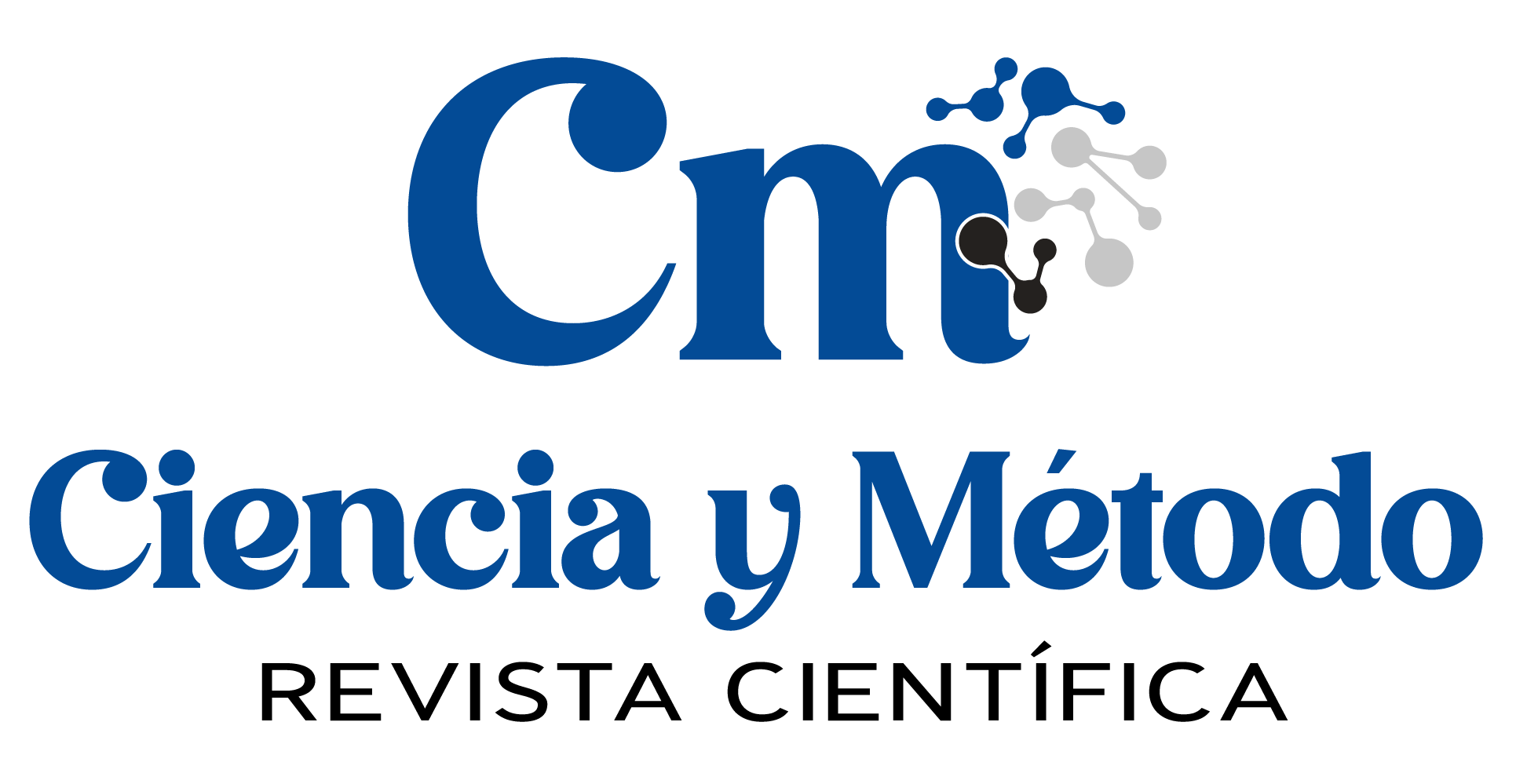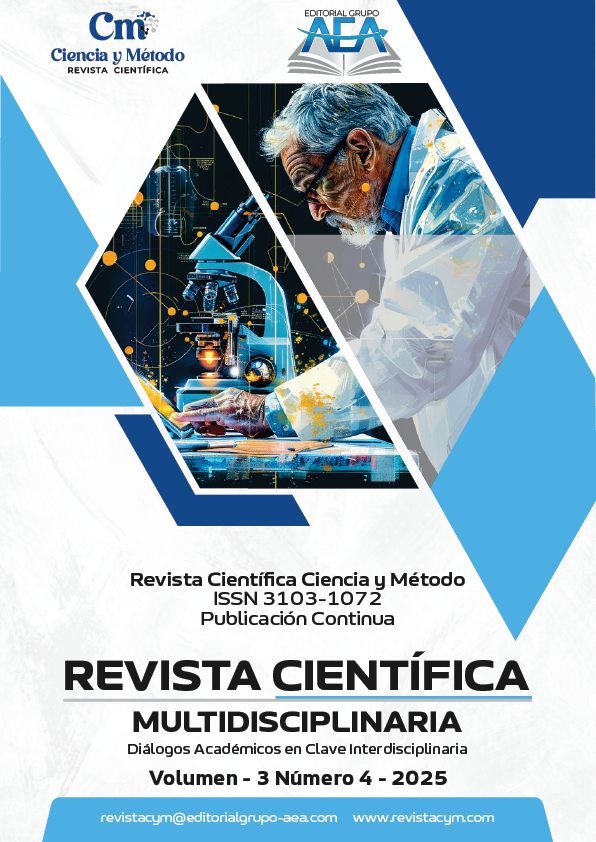ImageJ-assisted agronomy: efficacy of cocoa mucilage against Rigodium implexum and yield
Main Article Content
Abstract
Rigodium implexum moss negatively affects the productivity of cacao (Theobroma cacao). This study evaluated the effectiveness of cacao mucilage as a moss control and its effect on yield, integrating digital phenotyping with ImageJ to quantify moss coverage (%). The trial was conducted in Buena Fe (Los Ríos, Ecuador) under a completely randomized block design with four treatments, four replicates, and five useful plants per plot: chemical control (copper oxychloride) and mucilage at 75%, 50%, and 25%. Severity was measured weekly using standardized capture with scale, mm/pixel calibration, thresholding, and area measurement in ImageJ. The chemical treatment, 50% and 25% mucilage improved the number of flowers and fruits compared to the control; 25% mucilage achieved the highest moss control at five weeks, with observed reductions of 0% (week 1), 40% (2), 50% (3), 63.75% (4), and 77% (5). The findings support the use of mucilage as an organic and measurable alternative to mitigate R. implexum, with favorable effects on production variables and potential for adoption in sustainable cocoa management.
Downloads
Article Details
Section

This work is licensed under a Creative Commons Attribution-NonCommercial 4.0 International License.
How to Cite
References
Acheampong, K., Lowor, S. T., Owusu-Ansah, F., & Opoku-Ameyaw, K. (2013). Use of fermented cocoa pulp juice for the control of non-vascular epiphytes on cocoa. ARPN Journal of Agricultural and Biological Science, 8(3), 191–195. https://www.arpnjournals.com/jabs/research_papers/rp_2013/jabs_0313_535.pdf
Alarcón Restrepo, J. J., Arévalo Peñaranda, E., Díaz Jiménez, A. L., Galindo Álvarez, J. R., & Rosero, A. A. (2012). Manejo fitosanitario del cultivo del cacao (Theobroma cacao L.): Medidas para la temporada invernal. Instituto Colombiano Agropecuario (ICA). https://api.pageplace.de/preview/DT0400.9789588214993_A26246133/preview-9789588214993_A26246133.pdf
Ardhana, M. M., & Fleet, G. H. (2003). The microbial ecology of cocoa bean fermentations in Indonesia. International Journal of Food Microbiology, 86(1–2), 87–99. https://doi.org/10.1016/S0168-1605(03)00081-3 DOI: https://doi.org/10.1016/S0168-1605(03)00081-3
Arvelo Sánchez, M. A., González León, D. A., Maroto Arce, S., Delgado López, T., & Montoya López, P. (2017). Manual técnico del cultivo de cacao: Prácticas latinoamericanas. Instituto Interamericano de Cooperación para la Agricultura (IICA). https://repositorio.iica.int/handle/11324/6181
Barbedo, J. G. A. (2013). Digital image processing techniques for detecting, quantifying and classifying plant diseases. SpringerPlus, 2, 660. https://doi.org/10.1186/2193-1801-2-660 DOI: https://doi.org/10.1186/2193-1801-2-660
Bock, C. H., Poole, G. H., Parker, P. E., & Gottwald, T. R. (2010). Plant Disease Severity Estimated Visually, by Digital Photography and Image Analysis, and by Hyperspectral Imaging. Critical Reviews in Plant Sciences, 29(2), 59–107. https://doi.org/10.1080/07352681003617285 DOI: https://doi.org/10.1080/07352681003617285
Campuzano-Santana, K. L., Alarcón-Giraldo, V. D. ., & España-Lema, A. I. . (2025). Evaluación ambiental de sistemas agrícolas y forestales mediante análisis poblacional de nematodos como bioindicadores. Journal of Economic and Social Science Research, 5(2), 132-143. https://doi.org/10.55813/gaea/jessr/v5/n2/193 DOI: https://doi.org/10.55813/gaea/jessr/v5/n2/193
Castillo Balseca, K. A., & Flores Esquivel, E. F. (2023). Mucílago de cacao fermentada para el control de musgo (Rigodiumimplexum) en el cultivo de cacao (Theobroma cacao L.) CCN-51 en la parroquia Guasaganda [Tesis de licenciatura, Universidad Técnica de Cotopaxi]. Repositorio Institucional de la Universidad Técnica de Cotopaxi. http://repositorio.utc.edu.ec/handle/27000/10093
Coloma Coloma, T., Alulema Cuesta, M., España Escobar, Y., & Gualliche Serdán, L. (2017). Elaboración de un herbicida natural a partir de la pulpa mucilaginosa del cacao (Theobroma cacao). Revista DELOS: Desarrollo Local Sostenible, (29). http://www.eumed.net/rev/delos/29/herbicida-natural-cacao.html
Cubillos Bojacá, A. F., García Muñoz, M. C., Calvo Salamanca, A. M., Carvajal Rojas, G. H., & Tarazona-Díaz, M. P. (2019). Study of the physical and chemical changes during the maturation of three cocoa clones, EET8, CCN51, and ICS60. Journal of the Science of Food and Agriculture, 99(13), 5910–5917. https://doi.org/10.1002/jsfa.9882 DOI: https://doi.org/10.1002/jsfa.9882
Das Choudhury S, Samal A and Awada T (2019) Leveraging Image Analysis for High-Throughput Plant Phenotyping. Front. Plant Sci. 10:508. https://doi.org/10.3389/fpls.2019.00508 DOI: https://doi.org/10.3389/fpls.2019.00508
Franco-Pesantez, F., Benavides Rogel, O.A., Gavilanes Heredia, X.A., Alvarado Espinoza, T.M., & Zambrano Cabrera, C.A. (2023). Synergy: cocoa mucilage with acetic acid in the control of moss (Rigodium implexum) on criollo cocoa plantations. Journal of Agricultural Sciences Research (2764-0973). https://doi.org/10.22533/at.ed.9733122304087 DOI: https://doi.org/10.22533/at.ed.9733122304087
Guehi, T. S., Zahouli, I. B., Ban-Koffi, L., Fae, M. A., & Nemlin, J. G. (2010). Performance of different drying methods and their effects on the chemical quality attributes of raw cocoa material. International Journal of Food Science & Technology, 45(8), 1564–1571. https://doi.org/10.1111/j.1365-2621.2010.02302.x DOI: https://doi.org/10.1111/j.1365-2621.2010.02302.x
Herrera-Sánchez, D. J., & Gavilánez-Buñay, T. C. (2023). Estrategias de agricultura regenerativa para mejorar la salud del suelo. Revista Científica Ciencia Y Método, 1(2), 15-28. https://doi.org/10.55813/gaea/rcym/v1/n2/12 DOI: https://doi.org/10.55813/gaea/rcym/v1/n2/12
Lobet, G., Pagés, L., & Draye, X. (2011). A novel image-analysis toolbox enabling quantitative analysis of root system architecture. Plant Physiology, 157(1), 29-39. https://doi.org/10.1104/pp.111.179895 DOI: https://doi.org/10.1104/pp.111.179895
Mutka, A. M., & Bart, R. S. (2015). Image-based phenotyping of plant disease symptoms. Frontiers in Plant Science, 5, 734. https://doi.org/10.3389/fpls.2014.00734 DOI: https://doi.org/10.3389/fpls.2014.00734
Otsu, N. (1979). A threshold selection method from gray-level histograms. IEEE Transactions on Systems, Man, and Cybernetics, 9(1), 62–66. https://doi.org/10.1109/TSMC.1979.4310076 DOI: https://doi.org/10.1109/TSMC.1979.4310076
Sankaran, K., Mishra, A., Ehsani, R., & Davis, C. (2010). A review of advanced techniques for detecting plant diseases. Computers and Electronics in Agriculture, 72(1), 1–13. https://doi.org/10.1016/j.compag.2010.02.007 DOI: https://doi.org/10.1016/j.compag.2010.02.007
Schindelin, J., Arganda-Carreras, I., Frise, E., Kaynig, V., Longair, M., Pietzsch, T., Preibisch, S., Rueden, C., Saalfeld, S., Schmid, B., Tinevez, J.-Y., White, D. J., Hartenstein, V., Eliceiri, K., Tomancak, P., & Cardona, A. (2012). Fiji: an open-source platform for biological-image analysis. Nature Methods, 9(7), 676–682. https://doi.org/10.1038/nmeth.2019 DOI: https://doi.org/10.1038/nmeth.2019
Schneider, C. A., Rasband, W. S., & Eliceiri, K. W. (2012). NIH Image to ImageJ: 25 years of image analysis. Nature Methods, 9(7), 671–675. https://doi.org/10.1038/nmeth.2089 DOI: https://doi.org/10.1038/nmeth.2089





